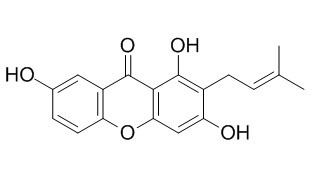1,3,7-Trihydroxy-2-prenylxanthone
1,3,7-Trihydroxy-2-prenylxanthone shows weak antibacterial activity against the bacterium.
Inquire / Order:
manager@chemfaces.com
Technical Inquiries:
service@chemfaces.com
Tel:
+86-27-84237783
Fax:
+86-27-84254680
Address:
1 Building, No. 83, CheCheng Rd., Wuhan Economic and Technological Development Zone, Wuhan, Hubei 430056, PRC
Providing storage is as stated on the product vial and the vial is kept tightly sealed, the product can be stored for up to
24 months(2-8C).
Wherever possible, you should prepare and use solutions on the same day. However, if you need to make up stock solutions in advance, we recommend that you store the solution as aliquots in tightly sealed vials at -20C. Generally, these will be useable for up to two weeks. Before use, and prior to opening the vial we recommend that you allow your product to equilibrate to room temperature for at least 1 hour.
Need more advice on solubility, usage and handling? Please email to: service@chemfaces.com
The packaging of the product may have turned upside down during transportation, resulting in the natural compounds adhering to the neck or cap of the vial. take the vial out of its packaging and gently shake to let the compounds fall to the bottom of the vial. for liquid products, centrifuge at 200-500 RPM to gather the liquid at the bottom of the vial. try to avoid loss or contamination during handling.
Food Chem Toxicol.2023, 176:113785.
Molecules.2023, 28(2):727.
Food Science and Human Wellness2022, 11(4):965-974
Int J Mol Sci.2024, 25(2):764.
Processes2024, 12(8), 1563
Molecules.2019, 24(24),4583
Nutrients2023, 15(18), 4016.
Phytofrontiers2024, 2690-5442.
Front Pharmacol.2021, 12:744624.
Microbiol. Biotechnol. Lett.2022, 50(2): 193-201.
Related and Featured Products
Ugaxanthone
Catalog No: CFN96469
CAS No: 13179-11-8
Price: Inquiry(manager@chemfaces.com)
Isojacareubin
Catalog No: CFN96573
CAS No: 50597-93-8
Price: Inquiry(manager@chemfaces.com)
1,3,6,8-tetrahydroxy-4-(3-methyl-2-buten-1-yl)-9H-Xanthen-9-one
Catalog No: CFN92541
CAS No: 1319198-98-5
Price: Inquiry(manager@chemfaces.com)
6-Deoxyjacareubin
Catalog No: CFN96276
CAS No: 16265-56-8
Price: Inquiry(manager@chemfaces.com)
1,3,7-Trihydroxy-2-prenylxanthone
Catalog No: CFN98022
CAS No: 20245-39-0
Price: Inquiry(manager@chemfaces.com)
1,7-Dihydroxy-3-methoxy-2-prenylxanthone
Catalog No: CFN97264
CAS No: 77741-58-3
Price: Inquiry(manager@chemfaces.com)
1,5,8-Trihydroxy-3-methoxy-2-prenylxanthone
Catalog No: CFN99202
CAS No: 110187-11-6
Price: Inquiry(manager@chemfaces.com)
1,4,5,6-Tetrahydroxy-7-prenylxanthone
Catalog No: CFN99016
CAS No: 1001424-68-5
Price: Inquiry(manager@chemfaces.com)
1,4,6-Trihydroxy-5-methoxy-7-prenylxanthone
Catalog No: CFN99675
CAS No: 160623-47-2
Price: Inquiry(manager@chemfaces.com)
O-Demethylforbexanthone
Catalog No: CFN97493
CAS No: 92609-77-3
Price: Inquiry(manager@chemfaces.com)
Chem Biodivers. 2004 Sep;1(9):1385-90.
Antimicrobial activity of hydrophobic xanthones from Cudrania cochinchinensis against Bacillus subtilis and methicillin-resistant Staphylococcus aureus.[Pubmed:
17191916]
METHODS AND RESULTS:
Ten xanthones with one or two isoprenoid groups and a prenylated benzophenone isolated from roots of Cudrania cochinchinensis (Moraceae) were tested for their antimicrobial activities against Bacillus subtilis and methicillin-resistant Staphylococcus aureus (MRSA). Among these compounds, gerontoxanthone H exhibited considerable antibacterial activity against B. subtilis (MIC = 1.56 microg/ml). Four xanthones, gerontoxanthone I, toxyloxanthone C, cudraxanthone S, and 1,3,7-Trihydroxy-2-prenylxanthone, showed weak antibacterial activity against the bacterium (MICs = 3.13-6.25 microg/ml).
CONCLUSIONS:
These compounds also exhibited similar MIC values against methicillin-sensitive S. aureus, MRSAs, and Micrococcus luteus.
Phytomedicine. 2005 Jun;12(6-7):510-3.
Antimicrobial activity of isoprenoid-substituted xanthones from Cudrania cochinchinensis against vancomycin-resistant enterococci.[Pubmed:
16008130]
METHODS AND RESULTS:
Ten xanthones with one or two isoprenoid groups and a prenylated benzophenone isolated from roots of Cudrania cochinchinensis (Moraceae) were tested for their antimicrobial activities against vancomycin-resistant enterococci (VRE).
CONCLUSIONS:
Among these compounds, gerontoxanthone H exhibited considerable antibacterial activity against five VRE strains (VanA, VanB and VanC) (MICs = 1.56 microg/ml). Four xanthones, 1,3,7-Trihydroxy-2-prenylxanthone, gerontoxanthone I, alvaxanthone and isoalvaxanthone, showed weaker antibacterial activity against these VREs (MICs = 3.13-6.25 microg/ml).



